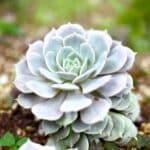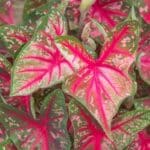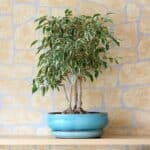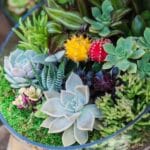Monstera Deliciosa and Borsigiana are beautiful houseplants with some striking differences and similarities.
They both look almost alike, and it’s usually difficult to differentiate between Monstera deliciosa vs borsigiana, which is why we wrote this post.
The most notable difference between both plants is that monstera deliciosa leaves is much bigger than that of Borsigiana. Also, monstera deliciosa has a wrinkled geniculum (the stem joint that connects the stem to the leaf or leafstalk), while Borsigiana has a typical one.
Read on as we highlight more interesting similarities and differences between monstera deliciosa and borsigiana.
Table of Contents
What is Monstera Deliciosa?
The Monstera Deliciosa is arguably the most common Monstera species, making it more popular than other varieties. This plant has southern Mexican origin, and it's popularly called 'Swiss cheese plant' because it has holey leaves that look like deli cheese.
The leaves in Monstera Deliciosa are heart-shaped with a leathery and glossy texture. Although it loses these attributes as it starts to mature.
Monstera Deliciosa can grow up to 10 to 15 feet and, even in some rare instances, can grow 30 feet tall. You now understand why it’s called Monstera Deliciosa, right?
Monstera Deliciosa rarely blooms, especially when housed indoors. However, the plant can produce flowers that feature a spathe in a lovely creamy white hue in the spring and summer seasons.
Related Post: Monstera Adansonii Vs Deliciosa
What is Monstera Borsigiana?

Borsigiana is basically a sub-species of the famous Monstera deliciosa. In terms of taxonomy, this plant belongs to the Araceae family and the Genus of Monstera. This plant can grow up to 2 meters on maturity, depending on the conditions.
Generally, Borsigianas are climbers by nature and thus make beautiful hanging plants, especially when they have a pole as support.
Borsigiana rarely blooms, especially when planted indoors but can breed small, non-showy flowers in spring and summer.
Generally, most plants in the Monstera family are quite toxic to humans and animals, and Borsigiana is no different. Finally, the plant is easy to care for, making it pretty suitable for beginners.
Monstera Deliciosa Vs Borsigiana
| Monstera Deliciosa | Monstera Borsigiana |
| Has bigger leaves | Has smaller leaves |
| Gaps between the nodes are shorter | Gaps between the nodes are longer |
| It sprawls across the ground before climbing | It climbs and grows taller faster |
| Has ruffles at the top of its petiole | Doesn’t have ruffles at the top of its petiole |
| Has a leathery leaf that can grow up to 3feet (1 meter) tall and wide | Its leaves can only grow up to 1.6feet (0.5meter) tall and wide |
How Is Monstera Deliciosa Different from Borsigiana?

As mentioned, while Monstera Deliciosa and Borsigiana share certain similarities that confuse new gardeners. We will highlight certain differences between these two plants below.
1. Monstera Deliciosa Has Bigger Leaves Than Borsigiana
Monstera Deliciosa is a true personification of its name. Monstera Deliciosa leaves can get to 18 or 30 feet when grown outside and about 5 feet and up when grown indoors.
At most, Borsigiana can only get to 1.6 feet each. This is actually a pretty standard size for most leaves, but when compared to Monstera Deliciosa, it is quite small.
2. Borsigiana Grows Faster than Monstera Deliciosa
What Borsigiana lacks in size, it makes up in growth rate. When the two plants are given similar care, the Borsigiana will grow faster than the Monstera Deliciosa by quite a large margin.
For instance, while Monstera Deliciosa grows 2 feet (1 meter) a year on average, Deliciosa can grow 30 feet (9 meters) within a year! Now you see there is quite a big difference in their growth rate.
Related Post: Cebu Blue Pothos Vs Philodendron
3. Monstera Deliciosa Has a Wavy or Wrinkly Geniculum While Borsigiana Has a Typical One
As already mentioned before, the geniculum, which is the stem joint that connects the stem to the leaf or leafstalk, is winkled in Monstera deliciosa, which has earned it the name Wrinkle Deliciosa or Wrinkled.
The wrinkled nature of the geniculum allows movement or flexibility.
In contrast, Borsigiana has a typical geniculum; the leaf base to the stem is only plain and straight.
Note that at the juvenile stage, both plants have a typical geniculum. Monstera deliciosa starts to have a wavy or wrinkly geniculum as it reaches full maturity.
4. Monstera Deliciosa Has a Horizontal and Sprawling Growth Characteristic While Borsigiana Has a Vining Growth Habit.
While both plants are natural climbers, Monstera Deliciosa tends to grow horizontally and spread on the floor. It is normal to find Monstera Deliciosa creeping down the ground. However, as they mature, they grow into their true climbing nature.
In the case of Borsigiana, right from the juvenile stage, they have a vining growth habit probably because it has a longer stem that grows along the ground or up a certain stack.
5. Different Stem Structure
Another identifiable difference between both plants is in the stem structure. Looking at the nodes of both plants (nodes are the round-like parts or spots that exist between the stem of a plant), you will notice that the Borsigiana has quite longer spaces between the petiole and stem.
This is unlike the chaotic Monstera Deliciosa, which has spaced petioles that are a bit distant from each other.
6. Monstera Deliciosa Is More Expensive Than Borsigiana
Apart from the telling physical characteristic, in terms of price, Monstera deliciosa is a more expensive plant ranging from $20 to $100 while Borsigiana is otherwise cheaper.
How is Monstera Deliciosa Similar to Borsigiana?
Remember that these plants are often mistaken for one another. Why is that? Well, let's explore the reasons below:
1. Both plants have a geniculum
The only difference is that the monstera deliciosa has a wrinkled geniculum while Borsigiana has a typical one.
However, looking at the basic functions of the geniculum, we realize that it promotes flexibility which helps the leaves seek out light if they're not getting enough sun. T
2. Both Plants prefer Bright, Indirect Light
While this is true, both Monstera Deliciosa and Borsigiana are quite tolerable plants. They can easily adapt to different lighting conditions, provided they're not under direct sun rays.
3. Both Plants Have the Same Watering Requirements
Both plants need to be watered when the first two inches of the soil have dried out. Refrain from watering when the soil is still moist. Yellowing, curled leaves, slow growth, and drooping are signs that both plants are underwatered.
4. Both Plants Thrive under a standard room temperature environment of 65 to 75 degrees and will die the temperature drop to 26 and 28 degrees.
5. Both Plants Both Prefer well-draining and acidic soil; the acidity should be between 5.5 and 6.5.
6. Both plants are Toxic to Pets & People
Most monstera species plants are toxic to people and animals and thus shouldn't be ingested. The insoluble calcium oxalates in these plants make them exceedingly dangerous to pets.
Related Post: Monstera Obliqua Vs Adansonii




